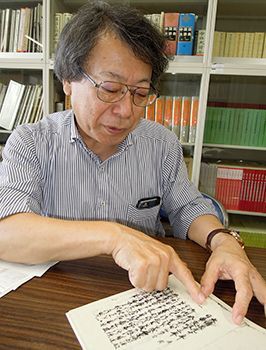In Okinawa, Chinese and Japanese imperial era names once both used

University of the Ryukyus professor Kazuyuki Tomiyama explaining the Chinese and Japanese imperial era names, which were both used in documents from the Rykyu Kingdom’s Sho Dynasty, on the afternoon of April 1 at the University of the Ryukyus.
April 2, 2019 Ryukyu Shimpo
The Japanese imperial era naming system has drawn attention recently, as the name “Reiwa” was chosen as the name of the new era that will follow Heisei. In Okinawa, there was a time when both the Chinese and the Japanese imperial era names were used. That period lasted roughly 300 years. “The imperial era naming system is closely connected to the monarch’s control over time,” says University of the Ryukyus professor Kazuyuki Tomiyama, who specializes in Ryukyuan history.
The imperial naming system originates from China, where “Jianyuan” (roughly 140 to 135 BC) in the Former Han Dynasty was the first imperial era to be named. Thereafter, the imperial naming system was adopted in Japan, Vietnam, and the Korean peninsula. In Japan, “Taika” and subsequent eras were named in accordance with the Japanese emperor system.
In Okinawa, the Chinese imperial era names were primarily used after the Ryukyu Kingdom entered into a tributary relationship with Ming China. According to Professor Tomiyama, the imperial era names were familiar to people at all levels of society in the Ryukyu Kingdom, which had long used the Chinese calendar.
Meanwhile, after the Ryukyu Kingdom was invaded by Japan’s Satsuma Domain in 1609 and fell under its control, the Japanese imperial era names came into use in consideration of interactions with the Edo government, but the Chinese imperial era names continued to be used primarily. In Sho Dynasty literature, Chinese imperial era names are written first, followed by the Japanese imperial name or “Japanese calendar year.”
The situation changed, however, after Japan’s Meiji government took over and set up the Ryukyu Domain. As a result of the 1879 “Ryukyu Disposition,” Chinese imperial era names disappeared from official documents. The Chinese imperial era names continued to be used in general society even after, but their popularity decreased after Qing China lost the First Sino-Japanese War, and they eventually fell out of use.
“In East Asia, the Chinese imperial era names were used primarily, and the Japanese imperial era names were used for interactions with Satsuma,” says Professor Tomiyama. “People tend to imagine that society is reset with every change of the imperial era, but actually the imperial era naming system is closely connected to the monarch’s control over time.”
(English translation by T&CT and Sandi Aritza)
Previous Article:Okinawans abroad lobby for support, endorsed by Nobel laureate
Next Article:“Even now colonialism continues.” Researcher calls for the restoration of self-determination for Okinawa 140 years after the Disposition of Ryukyu
[Similar Articles]
- Letters and lists of gift items sent by Ryukyu Kings to the Edo government recommended for inclusion in Important Cultural Properties of Japan
- National Taiwan University announces intention to return 63 Ryukyuan remains excavated from Nakajin
- Chinese classic documents from the Ryukyu Kingdom era published
- Beijing’s Ryukyuan burial sites under threat of development
- Okinawa Governor Onaga meets Chinese Premier
 Webcam(Kokusai Street)
Webcam(Kokusai Street)


